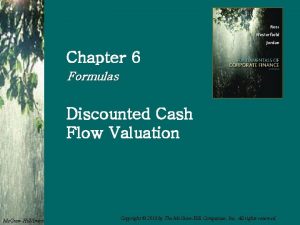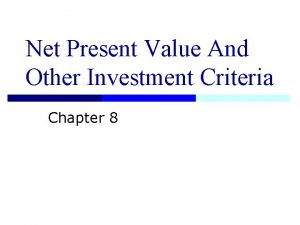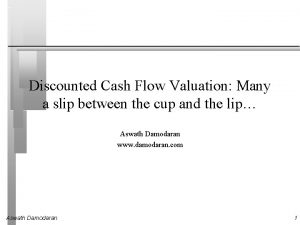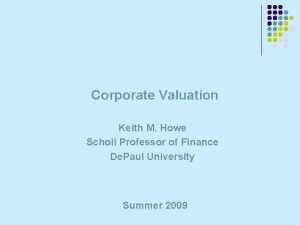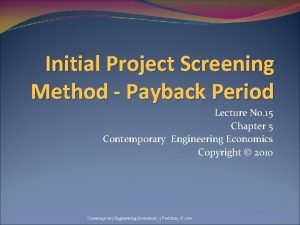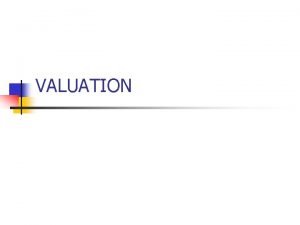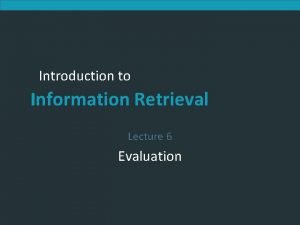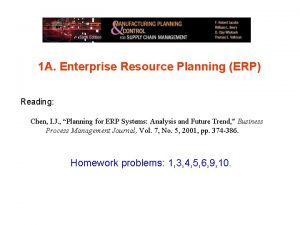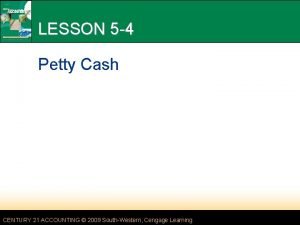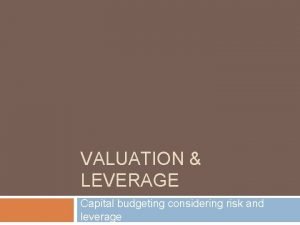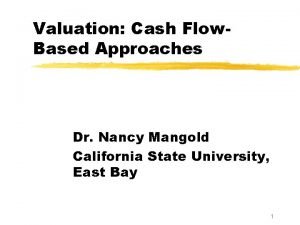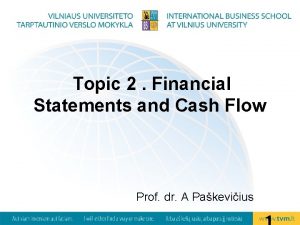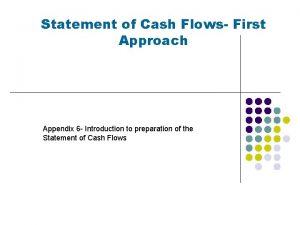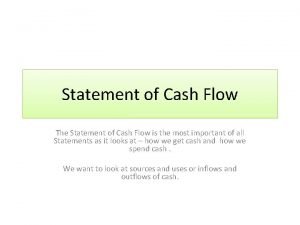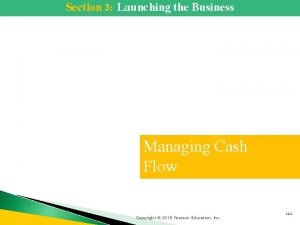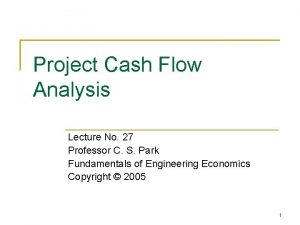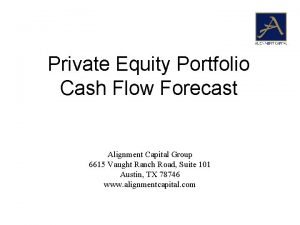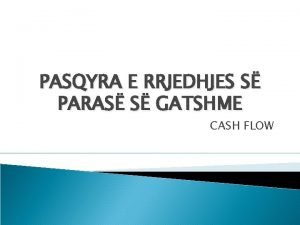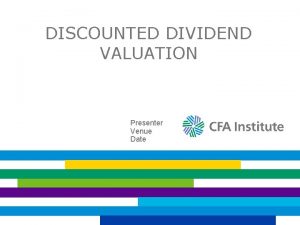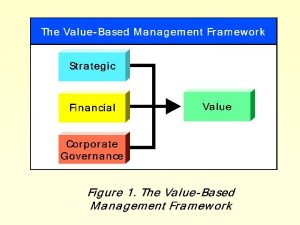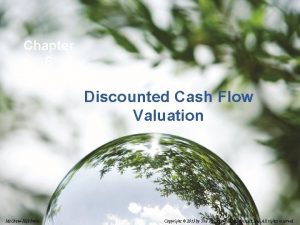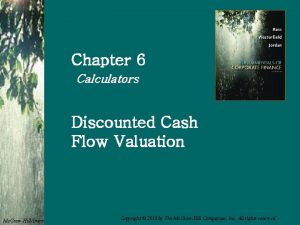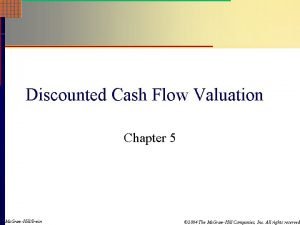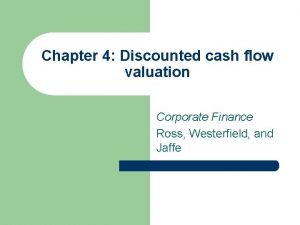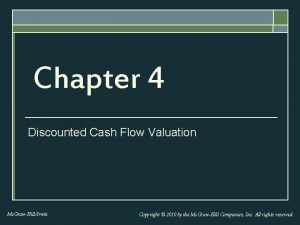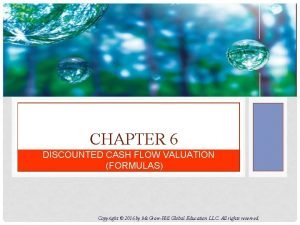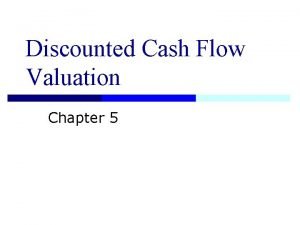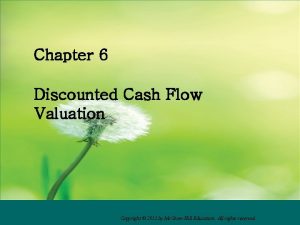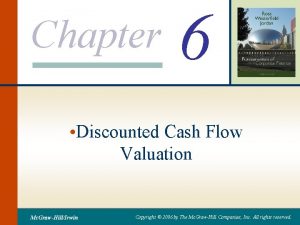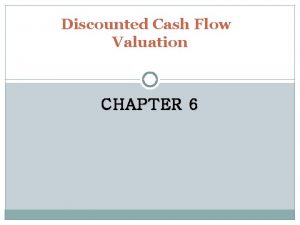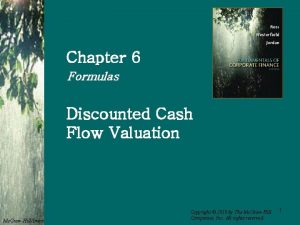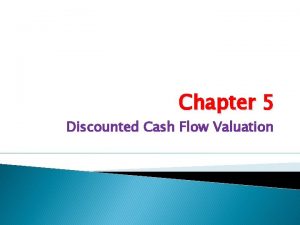Chapter 5 Discounted Cash Flow Valuation 1 Overview

































- Slides: 33

Chapter 5 Discounted Cash Flow Valuation 1

Overview n n n n Important Definitions Finding Future Value of an Ordinary Annuity Finding Future Value of Uneven Cash Flows Finding Present Value of an Ordinary Annuity Finding Present Value of Uneven Cash Flows Valuing Level Cash Flows: Annuities and Perpetuities Comparing Rates: The Effect of Compounding Periods Loan Types and Loan Amortization 2

Important Definitions n Annuity: A level stream of cash flows for a fixed period of time. n n Ordinary Annuity: Cash flows take place at the end of each period. Annuity Due: Cash flows takes place at the beginning of each period. Perpetuity: A level stream of cash flows forever. Note: For now computations will be shown using formulations and calculator entries. I recommend focusing on calculator entries because it is much more efficient in getting answers. Formulations are provided for demonstration purposes. You should also review Excel file to see how excel functions can be used. 3

Finding Future Value of an Ordinary Annuity N I/Y PV PMT FV 5 10 1 0 2, 000 -12, 210. 20 MODE 4

Finding Future Value of Uneven Cash Flows n Suppose you plan to deposit $100 into an account in one year and $300 into the account in three years. How much will be in the account in five years if the interest rate is 8%? n n FV can be computed for each cash flow at a common future period (in this case 5 years from today) FV = 100(1. 08)4 + 300(1. 08)2 = 136. 05 + 349. 92 = 485. 97 5

Finding Future Value of Uneven Cash Flows – Continued n n Calculator solution of the previous problem would involve determining FV of each payment in five years from today and then adding them N I/Y PV PMT FV 4 8 1 -100 0 -136. 05 2 8 1 -300 0 -349. 92 MODE Total FV = 136. 05 + 349. 92 = 485. 97 6

Finding Present Value of an Ordinary Annuity N I/Y PV PMT FV 5 6 1 -4, 212. 37 1, 000 0 MODE 7

Finding Present Value of Uneven Cash Flows n n n n Find the PV of each cash flow and add them Year 1 CF: 200 / (1. 12)1 = 178. 57 Year 2 CF: 400 / (1. 12)2 = 318. 88 Year 3 CF: 600 / (1. 12)3 = 427. 07 Year 4 CF: 800 / (1. 12)4 = 508. 41 Total PV = 178. 57 + 318. 88 + 427. 07 + 508. 41 Total PV = 1, 432. 93 8

Finding Present Value of Uneven Cash Flows – Continued 9

Finding Present Value of Uneven Cash Flows – TI BA II PLUS n When using CF make sure to clear previous entries n CF 2 ND CLR WORK 10

Example n n You are offered the opportunity to put some money away for retirement. You will receive five annual payments of $25, 000 each beginning in 40 years. How much would you be willing to invest today if you desire an interest rate of 12%? This cash flow set has two parts n n n PV of annuity payments 39 years from today PV of a single payment in 39 years See the timeline below 11

Example – Continued n PV of annuity 39 years from today n PV of single payment in 39 years 12

Example – Continued – TI BA II PLUS n n PV of annuity 39 years from today N I/Y P/Y 5 12 1 PV PMT FV -90, 119. 41 25, 000 MODE 0 PV of single payment in 39 years N I/Y PV PMT FV 39 12 1 -1, 084. 71 0 90, 119. 41 MODE 13

Example – Continued – TI BA II PLUS 14

Finding Future or Present Value of an Annuity Due n n n Annuity Due cash flows take place at the beginning of each period – this means that there is a payment now The immediate payment requires that we account its impact on FV and PV correctly The basic adjustments n n Treat the annuity as if it were an ordinary annuity and determine FV or PV Then multiply the answer by (1 + r) FV or PV of Annuity Due = (FV or PV of Ordinary Annuity) x (1 + r) If you are computing PMT then the adjustment is slightly different n n n PMT of Annuity Due = (PMT of Ordinary Annuity) / (1 + r) This is because immediate payment with annuity due reduces amount borrowed leading to lower overall payment I suggest using calculator settings for PMT, N, and I/Y computations 15

Finding Future or Present Value of an Annuity Due – Continued n Consider the above annuity due. n n n This is a five year annuity due. When you compute FV it is computed at the end of year 5. Assume 10% rate. 16

Finding Future or Present Value of an Annuity Due – TI BA II PLUS n To compute FV and PV of an annuity due you need to change MODE to BGN n n n 2 ND BGN 2 ND SET 2 ND QUIT Once complete you will see BGN on the display To return to END follow the same steps END mode is not displayed N I/Y PV PMT FV MODE 5 10 1 0 400 -2, 686. 24 BGN N I/Y PV PMT FV MODE 5 10 1 -1, 667. 95 400 0 BGN 17

Example n Suppose you win the Publishers Clearinghouse $10 million sweepstakes. The money is paid in equal annual installments of $333, 333. 33 over 30 years. If the appropriate discount rate is 5%, how much is the sweepstakes actually worth today? N I/Y P/Y 30 5 1 PV PMT -5, 124, 150. 29 333, 333. 33 FV MODE 0 18

Non Annual Interest Earnings (Compounding of Interest Rate) and Payments n n Remember that FVt = PV 0 x (1 + r)t When dealing with non annual interest and payment you should make two adjustment n n n Formulations should be adjusted as follows n n Interest rate should be periodic Number of periods should reflect the total number of periods given number of years and frequency of interest earnings in a year If “m” is the number of compounding in a year then where you see “r” divide it by “m” and multiply “t” by “m” This assumes that “t” is the number of years FVt = PV 0 x (1 + r/m)t X m Excel adjustment are same as formulations that can be made in a function dialog box or data cells 19

Non Annual Interest Earnings (Compounding of Interest Rate) and Payments – Continued n n n FVt = PV 0 x (1 + r/m)t X m Entering the above equation into TI BA II PLUS Method 1: n n n Keep P/Y = 1 (so is C/Y = 1) N = t X m (Number of periods) I/Y = r/m (Periodic interest rate) Rest of the information is entered as before Method 2: n n n Change P/Y = m (so is C/Y = m) N = t X m (Number of periods) I/Y = r (Annual interest rate) Rest of the information is entered as before Note that P/Y has to be checked for consistency every time 20

Example Buying a Car n Suppose you want to borrow $20, 000 for a new car. You can borrow at 8% per year, compounded monthly. If you take a 4 -year loan, what is your monthly payment? 21

Example Buying a Car – TI BA II PLUS n Note the adjustment 2 ND P/Y 12 ENTER 2 ND QUIT N I/Y PV PMT FV 48 8 12 -20, 000 488. 26 0 MODE 22

Example Credit Card n n Note: Finding interest rate and number of periods in annuity formulations are relatively time consuming. By this point you should be more comfortable with your calculator. From now on, solutions will be shown based on calculator entries. You ran a little short on your spring break vacation, so you put $1, 000 on your credit card. You can only afford to make the minimum payment of $20 per month. The interest rate on the credit card is 1. 5 percent per month (18% per year compounded monthly). How long will you need to pay off the $1, 000. N I/Y PV PMT FV 93. 11 18 12 -1, 000 20 0 MODE 23

Example Borrowing Money from Unlikely Resources n Suppose you borrow $10, 000 from your parents to buy a car. You agree to pay $207. 58 per month for 60 months. What is the annual interest rate compounded monthly? N I/Y PV PMT FV 60 9. 00 12 -10, 000 207. 58 0 MODE 24

Present Value of a Perpetuity n n Suppose you will receive a fixed payment every period (month, year, etc. ) forever. This is an example of a perpetuity You can think of a perpetuity as an annuity that goes on 25

Example Perpetuity n n What should you be willing to pay in order to receive $10, 000 annually forever, if you require 8% per year on the investment? PV = $10, 000 / 0. 08 = $125, 000 26

Effective Annual Rate (EAR) vs. Annual Percentage Rate (APR) n Effective Annual Rate (EAR) n n Annual Percentage Rate (APR) n n n This is the actual rate paid (or received) after accounting for compounding that occurs during the year If you want to compare two alternative investments with different compounding periods you need to compute the EAR and use that for comparison. Sometimes it is also called Annual Percentage Yield (APY) or Effective Rate This is the annual rate that is quoted by law By definition APR = periodic rate times the number of periods per year Consequently, to get the periodic rate we rearrange the APR equation: Periodic rate = APR / number of periods per year Sometimes it is also called Stated Rate, Quoted Rate or Nominal Rate You should NEVER divide the effective rate by the number of periods per year – it will NOT give you the periodic rate 27

Rate Conversions n APR to EAR n EAR to APR n Calculator convention n NOM EFF C/Y = APR = EAR =m 28

Example Rate Conversion n You are looking at two savings accounts. One pays 5. 25%, with daily compounding. The other pays 5. 3% with semiannual compounding. Which account should you use? n n 5. 25% compounded daily n n n 2 nd ICONV NOM 5. 25 C/Y 365 CPT 5. 39 ENTER 2 nd ICONV NOM 5. 30 C/Y 2 CPT 5. 37 ENTER (EFF) 5. 30% compounded semiannually n n n Compare EAR and choose the larger one since you are investing. If you were borrowing then you would choose the lower EAR alternative (EFF) Choose 5. 25% compounded daily 29

Example Rate Conversion – Continued n Let’s verify the choice. Suppose you invest $100, 000 in each account. How much will you have in each account after 5 years? n Daily Compounded Account: I/Y PV N 1, 825 n n 5. 25 365 -100, 000 PMT FV 0 130, 015. 19 Semiannually Compounded Account: N I/Y PV PMT FV 10 5. 30 2 -100, 000 0 129, 894. 13 You have more money in the first account. MODE 30

Amortized Loan with Fixed Payment n n Each payment covers the interest expense plus reduces principal Consider a 4 -year loan with annual payments. The interest rate is 8% and the principal amount is $5, 000. N I/Y PV PMT FV 4 8 1 -5, 000 1, 509. 60 0 MODE 31

Amortization Table Year Beginning Balance Interest Paid Principal Paid Ending Balance 1 5, 000. 00 1, 509. 60 400. 00 1, 109. 60 3, 890. 40 2 3, 890. 40 1, 509. 60 311. 23 1, 198. 37 2, 692. 02 3 2, 692. 02 1, 509. 60 215. 36 1, 294. 24 1, 397. 78 1, 509. 60 111. 82 1, 397. 78 0. 00 6, 038. 42 1, 038. 41 4, 999. 99 Totals n Total Payment Computations: n n n Interest Paid = Beginning Balance X Interest Rate Principal Paid = Total Payment – Interest Paid Ending Balance = Beginning Balance – Principal Paid 32

Amortization Table – Continued n If you want to determine the outstanding balance of the loan after 2 years: n n 2 nd AMORT 2 ENTER n n This will allow you to see loan information at that point in time. You can change P 1 and P 2 to get the data for the specified payment range 33
 Chapter 6 discounted cash flow valuation
Chapter 6 discounted cash flow valuation Bcr formula
Bcr formula Discounted cash flow
Discounted cash flow Discounted cash
Discounted cash Valuation of fixed income securities or valuation of bonds
Valuation of fixed income securities or valuation of bonds Chapter 2 financial statements taxes and cash flow
Chapter 2 financial statements taxes and cash flow Payback period formula
Payback period formula Payback time formula
Payback time formula Advantage of payback method
Advantage of payback method Justified trailing p/e
Justified trailing p/e Old mutual wealth discounted gift trust
Old mutual wealth discounted gift trust Discounted rate of return
Discounted rate of return Discounted cumulative gain
Discounted cumulative gain Discounted gift trust 10 year charge
Discounted gift trust 10 year charge Cash to cash cycle time
Cash to cash cycle time Cash to cash cycle time
Cash to cash cycle time Cash in cash out example
Cash in cash out example Production budget example
Production budget example Paid cash to establish a petty cash fund
Paid cash to establish a petty cash fund List six reasons why a bank may dishonor a check.
List six reasons why a bank may dishonor a check. Debt capacity
Debt capacity Residual cash flow
Residual cash flow Cash flow to stockholders formula
Cash flow to stockholders formula Cash first approach
Cash first approach Salaries paid in cash flow statement
Salaries paid in cash flow statement Strategic assessment in software project management
Strategic assessment in software project management Discount cash flow method
Discount cash flow method Difference between cash flow and revenue
Difference between cash flow and revenue Cash flow table
Cash flow table Private equity cash flow forecasting
Private equity cash flow forecasting Free cash flow to firm
Free cash flow to firm A savings option many employers offer is
A savings option many employers offer is Pasqyra cash flow
Pasqyra cash flow Pasqyra e cash flow
Pasqyra e cash flow
